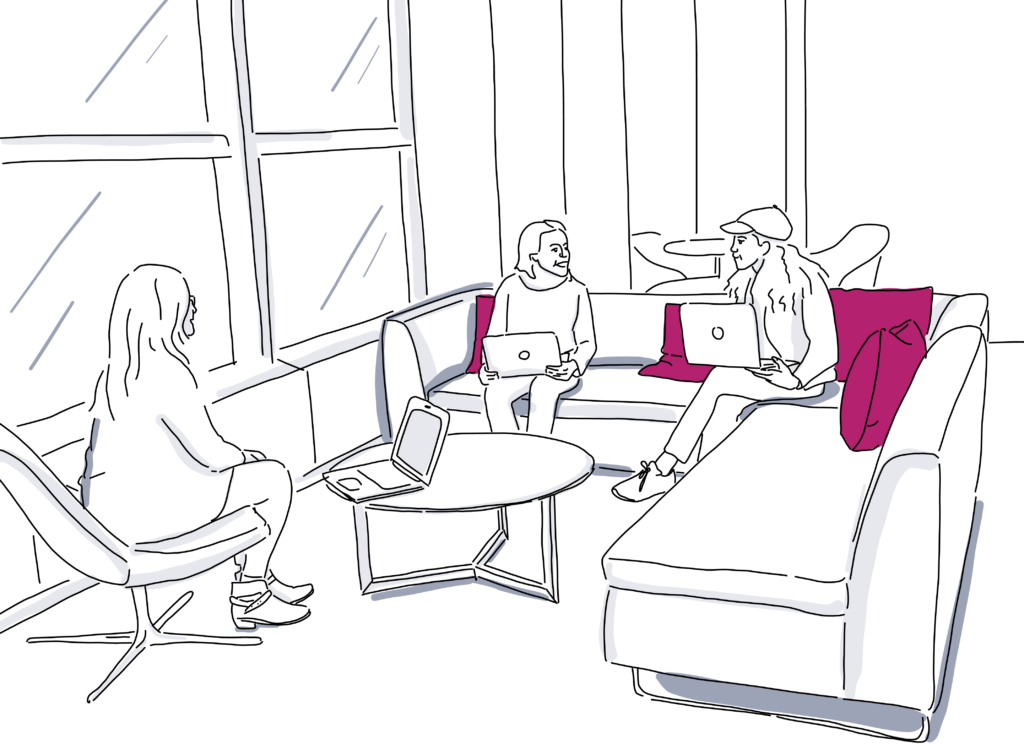
Friday Finds: How to Create Hotel Workspace to Boost Revenue
With the rise of bleisure travel, remote working, and the gig economy, many hotels are seeing more travelers than ever who want to work from their space. Gone are the days when the most important parts of the hotel were the guest rooms. Instead, travelers are spending time in areas that were previously transient: lobbies, business centers, patios, and rooftops have become spaces for work, networking, socializing, and more. So how do hotels adapt to the change in behaviors and capitalize on the trend? One possible way is with on-demand workspaces.
On-demand workspaces are areas within the hotel that have been converted to desk space, meeting rooms, areas for private calls, or even coworking spaces. They are typically available to hotel guests for free (or a nominal amount), and to the public for hourly or daily rates. They are incredibly useful for hotel guests who want to get some work done, and can be a valuable additional revenue stream for hotels.

Discover 8 reasons why hotels are creating on-demand workspaces
While catering to business travelers is nothing new for the hotel industry, business centers of the past were more often a nod to accomplishing a few work-related tasks on the road. But expectations of when, where and how people work have changed dramatically in recent years. For many people, expectations of the workplace have changed too. Working alone in a hotel room or from a noisy lobby no longer meets the needs of flexible workers, who have come to expect a higher standard of workspace that’s collaborative, open, and tailored for their needs.
It is clear that guests are looking for something more out of their hotels, but these types of changes are not without their costs. Why would creating these working environments be worth the expense?
1. There is a large demand.
Flexible office space demand has increased by 21% annually since 2010, and shows no sign of slowing down. The number of coworking members is expected to jump to 3.8 million in 2020. With so many travelers looking for flexible places to work, providing that service where they are staying is almost a no-brainer.
2. The work will happen somewhere.
Employees, especially those traveling for their jobs, get work done in coffee shops, restaurants, or co-working spaces. But hotels are catching on to the trend and beginning to market their spaces as superior options for both local companies and business travelers.
3. You have the space.
Hotels have many environments”both open space areas as well as enclosed meeting rooms”that are largely going underutilized. Spaces like the lobby, business center, patios, garden areas (in warmer climates), and event spaces are all able to be converted relatively easily into flexible working environments.
4. It can be basic.
Workers are mainly looking for wifi, the ability to charge devices, and a place to get some work done. It doesn’t have to have lunch or coffee service, and may only need minimal staffing.
5. It boosts revenue.
Renting out your underutilized public spaces by the hour or day offers an added revenue stream that doesn’t follow your hotel’s typical cycles and patterns, potentially shielding you from the highs and lows of seasonality and large events.
6. It spreads beyond the workspace.
The added revenue also filters out to other areas of the hotel such as restaurants, lobby shops, cafes and more, as visitors look to explore the facilities and remain under one roof.
7. It feels good.
Besides generating revenue, on-demand workspaces can also help hotels generate positive guest experiences and make guests feel that their needs are understood.
8. It increases loyalty.
If your bleisure traveler thinks of your hotel workspace as their office while on the road, they are more likely to stay each time they are in town.
For many hotels, these reasons add up to a clear vote in favor of creating a flexible work environment. But how can hotels effectively create these spaces?

Explore 7 ways to create the best hotel workspace
1. Stay flexible.
Your space should be capable of multiple configurations. Consider adjustable-height surfaces for standing or sitting, tables that allow for small groups to gather within larger, presentation-ready rooms, or semi-private breakout spaces for casual conversation. Consider event modular furniture components that can be moved, mixed, stacked, and stowed.
2. To save on space and expense while encouraging collaboration, consider a few shared tables.
This creates a homier environment, promoting the increasingly family-style, collaborative work that is happening among flexible workers.
3. Let the sunshine in.
Natural light has been shown to boost productivity, so consider setting up your workspace in an area with good light. Make sure to check the space throughout the day for any harsh glare on computer screens, and install light-filtering blinds as necessary.
4. Stay connected.
The number one thing that workers need is connectivity, with fast, reliable wifi and enough outlets to charge their devices. Missing these key pieces will see your guests heading straight for the nearest coffee shop.

5. Go beyond just a desk.
Consider all the ways that workers will want to use your space, including group meetings, one-on-one conversations, and private phone conversations.
6. Encourage loyalty.
Many of the hotels that offer coworking do so for free to their guests, and only charge workers who are not staying in the hotel. This encourages loyalty among your guests, while offering a valuable benefit during their stay.
7. Engage with the community.
Consider transforming the space into an event space in the evenings, where coworking members can get together for networking, learning, or engaging with great speakers. You could even help with organizing the programming to bring in relevant presentations and build up the buzz around your space.
Throughout this process, room management and operations should remain the core priorities, and lobbies must remain functional. Your flexible working areas need to create the right environment that fits both your hotel’s brand and the needs of those using the space. This may be accomplished by offering separate areas for those looking to relax and for those looking to work, or by using modular furniture to change the look and feel of the layout throughout the day.
The most important thing to keep in mind is creating a space for connecting – your transient guests, traveling professionals, entrepreneurs, and the local community will thank you for it. While building a coworking space may not suit all guests or all hotels, for hotels with certain guest personas and types of travelers it does make a lot of sense. And for many hotels, this trend represents a step towards the future of work and hospitality.
Ready to outfit your own on-demand workspace?
Make sure to take a look at your group sales CRM and build your hotel guest personas first so that you can customize the space!

